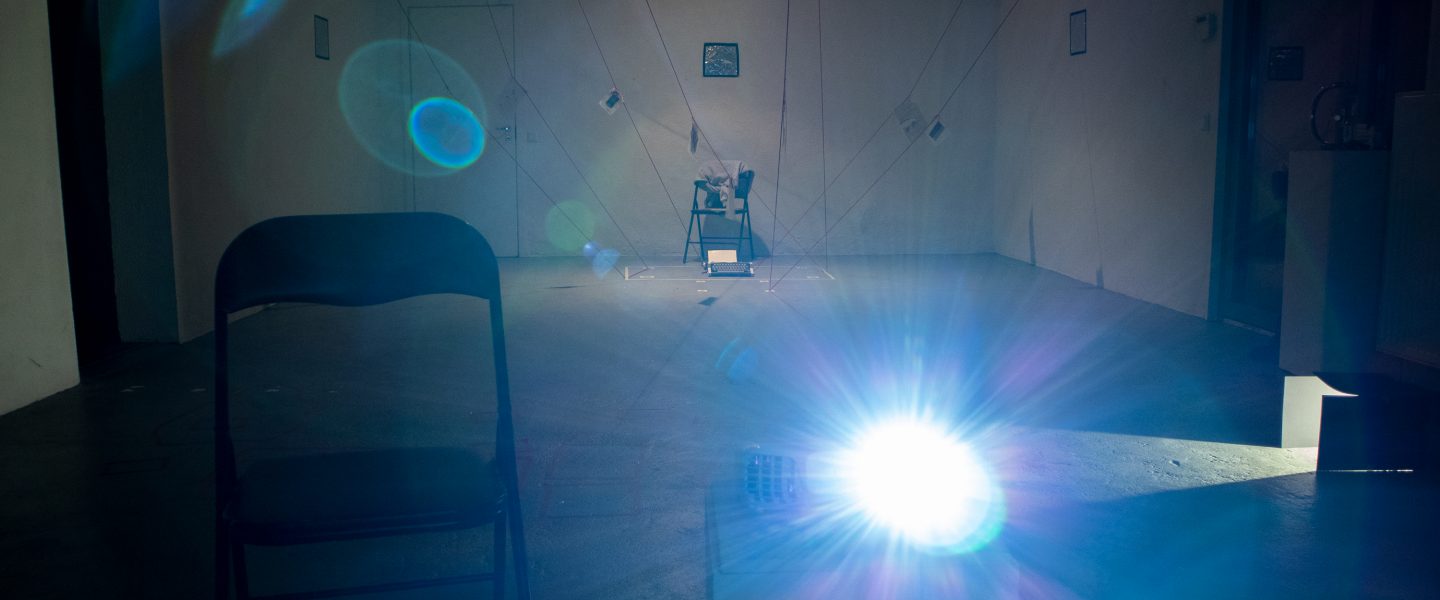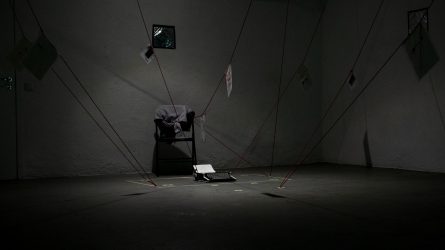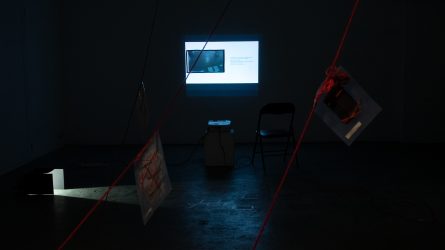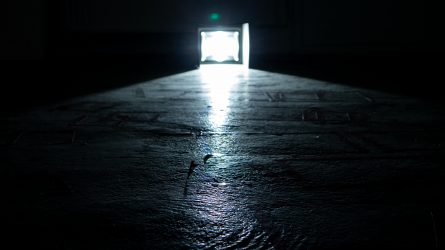
Documentation photo of the Vent Space residency programme.
Vent Space introduces another two artists, who participated in our residency programme: Bohdana Korohod and Tõnis Jürgens.
Bohdana Korohod (b. 1997) is an Estonia-based interdisciplinary artist from Ukraine. Her works are aimed at a dialogic praxis, between individual (hi)stories, identities, personal and collective. Growing from confessional art, Bohdana’s practice borders on documentation and fiction in attempt to explore one’s positionality while still striving for transformation and active stance. With the background in social sciences (Kyiv-Mohyla Academy, Ukraine/Leiden University,
the Netherlands) she started her artistic journey as a photographer and a documentary filmmaker. After starting her MA program in Sound and Visual Technology (UT Viljandi Culture Academy, Estonia) she’s been engaged in both visual and performing arts. From May 2020 she’s a part of eˉlektron.art where she’s also a curator of the
artistic&experimental program “fruitful misunderstandings”.
Tõnis Jürgens is a PhD student in EKA. He has a backround in new media, culture theory and anthropology.
The result of their collaboration is seen in an interview between Bohdana and Tõnis. He asks and she answers.
Bohdana’s week-long residency at Vent Space was part of developing her ongoing Master’s project at Viljandi Kultuuriakadeemia. Her work is related to memories and interrogation, abusive relationships and shame. At our meetings, the conversation often veered off to discuss matters like crime scene investigation, loss, plumbing, the etymology of genitalia, feminism, alien abductions, Sixto Rodriguez, and more – but I quickly forget most of it, and the few short rambling notes in my little black notebook give little hope as to communicating something sensible. Thusly, in a final effort, we sit down once again, now with a recording device at hand, and try to remember what we had already talked about.
So, can you shortly tell me about your project?
How do you do that, shortly?
It’s called “interrogation / room / in progress”. It’s a room installation that uses the language of remembering and it’s context is tied to sexual and emotional abuse in relationships. The texts that are used in the installation are personal objects or belongings that I had at home, based on which I wrote testimonies. The whole thing is basically a process of interrogating myself about certain past relationships, how I relate to them now, how I related to them before, how it changed and why.
When we first met you mentioned something like layers of misinterpretation – and also Herbert Marcuse, whose texts you’ve been inspired by. How do you mean “misinterpretation” in memories and how is all this related to Marcuse?
I wouldn’t call it “misinterpretations”, just different interpretations. I look at events in my life, but depending on from where I look at them, my relation to those memories change, as do the memories themselves.
According to Marcuse, by remembering something you were either made to forget or what is not accepted to be remembered – either by certain groups or societies or in certain environments – you can oppose such oppressive structures. And for me the point wasn’t in just stating some facts or telling a story or something like that, but I was trying to incorporate the structure of how memories are built, how we remember certain things, in the installation itself, and to make it explicit that these are not fixed-in-stone events or memories from my life, but interpretations of them.
What was your initial drive to start with this project, where does it come from?
That’s very far in the past. I was working with memory studies when doing my BA thesis. Then, after graduation, I dropped the topic completely – until last September, when I was taking an experimental painting course in Tartu. We were supposed to make a final project, I was playing with different ideas, and memory studies came up again.
At the same time I was working with Maria Paiste, the actress, with whom we were planning a performance. We started working with the topic of abusive relationships. Somehow this memory studies theme and the context in which we were working with Maria ended up coming together in this project. And the form of it kind of created itself, because originally it was supposed to be a durational piece performed by Maria and me.
I think one of the important aspects that you first mentioned about the project was the keyword “shame”; navigating shame through memories or putting it into the context of this abstract interrogation room.
The shame came in the end. Or the realization that the installation had implied shame in it, about which I wasn’t aware myself. What I noticed in myself as I was going through these memories alone is that there are many moments, which I tend to omit. I would reach a certain memory, and it’s just like: it doesn’t matter, let’s leave it. I started describing this as “self-censorship”.
Meanwhile I had a parallel process with Maria, and one of the keywords that we wanted to explore was “shame”, because we felt that there might be some connection, but we didn’t know what kind exactly. When we started working through it, for both of us, it first seemed as if we had no feelings of shame or we hadn’t really experienced it that much, so for a while we decided to drop this theme.
But then the topic of shame started appearing from different sources. The main turning point came with the Polish theatre director, Małgorzata Wdowik, whose last performance is basically called “Shame”. I stumbled upon an interview with her about this performance. She was talking about generational shame, how shame is engraved in her family along the female line, from her grandmother to her mother and to herself – and how it’s all in the same structure and how she was exploring it through her work.
After reading that interview, some of the things she said really stuck with me, and I thought that maybe we should go back to this topic with Maria, to ask ourselves if it’s really true that there’s no shame and that it has no importance whatsoever in our identities. Maybe we were really just denying it so well that even while talking about it there was nothing coming up. We decided to concentrate on the shame, to dig deeper regarding shame in our memories. And as soon as we started targeting it consciously, it turned out that there’s a whole fucking lot related to shame.

Then I showed Maria the installation I was working on in Tartu, and told her I call this phenomenon “self-censorship”. She asked me if I was sure whether “self-censorship” was the most precise word to describe it. I realized that what I was calling self-censorship was also my own denial of experiencing shame or embarrassment, and also shame about experiencing shame.
Shame became implicitly present in the installation. I don’t really use the word “shame” in any way, but this act of hiding something was there from the beginning. It wasn’t a conscious decision, but while I was writing my testimonies I felt that I can’t just show them as they are. Post-factum, I felt that the reason for this was me being ashamed of showing them this way. So now it seemed even more appropriate to keep it in the way I’d already been doing it.
With this you mean the testimonies being half-destroyed and covered up with a red line, in that way?
Yeah. Those covered parts, I didn’t retype or redo anything. During the residency I was trying to understand why I did them in this way, whether I would change something, what is actually behind all those red things with which I hide some parts. I think memories are already a fabrication of real life events.
That’s another thing we already talked about – that memories don’t constitute reality in the same sense as words are also compromises between people. You always leave something out for the other to understand it better, or to get the message across, let’s say.

For me this whole thing is a process of remembering. As soon as you lay out a certain memory, if you go back to it, you can always question whether it really was this way, if I really felt that way back then, or if it’s simply how I feel at the moment. I was trying to recreate this process of how you try to reach out to some events in the past, but end up with only memories, and memories of memories.
But this interrogation room, the idea of it sort of puts this notion of a power struggle into the act of remembering. These aren’t just memories for your own sake, you’re presenting them to someone else. And the interrogation room as such implies some sort of aggression. I think we talked about that as well. I can’t exactly remember what we came to with that…
(Laughs) That there is a lot of violence in the installation itself. In the end there were four people who came to see the installation in Vent Space. One of them was a woman. Everyone mentioned that there is some violence present in it, that it makes them feel uneasy or uncomfortable. But when I asked the one woman who came to see it how she felt in that space, first she turned to me and said, “Thank you, I feel understood.” For her that was the main takeaway. Then we started talking about whether she feels or senses any violence present. She evetually said that she does feel some violence, but that it’s me performing violence against myself.
But the men were more uneasy, we were more ill at ease?
Yeah, more uneasy, and, I don’t know, maybe even felt attacked to a certain degree.
I guess, yeah, considering that there’s implicit hints to a past relationship of yours.
Mhm.
And even though you don’t mention the shame or aggression in itself, I could somewhat relate to being scrutinised in that form of an exhibition. I’m speaking for myself, not for men in general, but I sort of felt that there’s a certain latent anger present in the work, to which you said that you actually want this anger to not be so visible or present.
No, I don’t want it to be the end point. Whatever was built in the space, I don’t feel that it’s something that I would present as a final work. I think that I wouldn’t like to end it there, personally. And I also wouldn’t like to make a kind of factual statement that this is how things are and this is it, but to rather try and look for how you could walk out of this space, even without physically just leaving the space. But I haven’t figured out how to create this passage.
I started from going back to these events in my life, trying to understand why there’s such a pattern and what was the reason for my allowing it to happen again and again. From there I came to the notion of shame and what it could be related to. In a way it seems that the feeling of shame or the state of being ashamed is the basis of many human interactions in general. But that’s what I came to in the end, not where I was starting from or willing to explore in the beginning.
Really? How do you mean that shame is the basis for many human interactions?
Now I’ll be talking with words that I’ve read and not my own, probably, but for example, in one of the research materials I looked at there was the idea that in shame and sexuality lay the history of civilizations. The researcher was going through historical materials starting from Genesis and Adam and Eve being cast out from the garden of Eden, feeling ashamed for the first time. They were shamed out and they were made to be ashamed of their sexuality that is also related to the naked body. There are direct relations between shame and femininity as well. Femininity not as exclusively related to women, but in this general binary structure of masculine-feminine, which is also rooted in language. Shame is very often included in the names of female reproductive organs, for example in German, where Schamlippen stands for vaginal lips – Scham means shame. And that’s not only in German, its roots are in Latin. The term pudendum, which stands for the outer genitals of girls and women, is derived from the Latin pudenda membra, which means “a part to be ashamed of”.
If you look at basic Freudian literature, everything is rooted in sexuality and the control of sexuality. The easiest way to control it is by shame, by creating this concept of what is shameful and what is not. In a way, shame is the culture itself, and how it controls our behaviour and our interaction. We’re not allowing ourselves to act in certain ways, because we know that we would feel embarrassed afterwards. It’s not written in the laws… Well, sometimes it is (laughs). But most of it’s not written in the laws or not even directly spoken. You just know that you can’t do certain things, because you already have the feeling of embarrassment, even before actually doing it. This prevents you from doing it. From one side it helps us to maintain some kind of more-or-less structured functioning society, without too much of transgression, but at the same time it is a tool of control and power. And the easiest example is toxic masculinity. Because it doesn’t come out of nowhere, it stems from certain repressions.
Do you consider making artworks a therapeutic process? And is that okay by you, is that enough?
(Long pause) I see that it actually happened, that it turned out to be a therapeutic process. But at the same time, I had been in therapy before doing it. So that influenced it also. However, I don’t think that it’s a good idea to work on something or to create something as therapy. I think it’s better to get proper treatment first (laughs), and if you still consider it relevant or necessary to go back to the same experiences, to create something in place of getting treatment, then I would say the work becomes contaminated by your negative experience in a way. It will never be what you would like to make or to share with someone – while being in a clear state of mind, so to say. The result would be as if something is contaminated by something else. That’s also one of the reasons why I would not present this installation as a final work in itself. In a way I think it’s still preserved some kind of contamination in it.
At a certain point I realized I can’t take in any more anger or darkness or disappointment or pain from the artworks around me, because that’s no different from scrolling on Facebook. In the end, whatever you create, you create out of yourself, and if you have any issues or unresolved problems, they’ll show up in your work. The danger with these unresolved issues is that usually they can go unnoticed and instead of communicating something profound, they will just contaminate your work. So even if you do talk about or if this is what you want to communicate to someone else, if it’s still unprocessed in yourself you end up just throwing up on another person instead of building a certain dialogue or communicating something. Full stop (laughs)

That’s interesting to hear because as I’ve mentioned before, I’m personally sceptical about or get ill at ease when people put explicit personal things in their work, and I don’t usually do that myself. I start from the other end – I make it as general as possible, and then sort of work my way down to the level where I can perhaps attach some personal meaning onto the work.
I was recently reading Pierre Bourdieu’s “Reflexive Sociology”. He mentions there that his approach is always to go into something very particular, very unique, usually to find in it the universal. So it’s not that you start from some universal notions or some sociological concepts and you try to see what could be different in certain fields, but rather that you right away dive into something very particular, and in the end it’s apparent that there is actually no uniqueness, because the particular fits into something very general or something very common. Bourdieu was initially criticised a lot, because why would you do this. But then it became, I think, a kind of trend in most of the humanities, to go into these micro histories.
I was just reminded of a film called “Stories We Tell”. Have you seen it?
I think no…
It’s a film by Sarah Polley, about her mother, which is made from family archive footage that she digs out. It’s her interviewing relatives and friends to talk about her mother who died when she was 11 years old. So she’s trying to remember a mother who was only present in her childhood… And maybe I shouldn’t say any more, otherwise I’m going to spoil it.
This phrase, “stories we tell”, reminds me of another film, “The Tale” by Jennifer Fox. It’s also based on the writer-director’s own life. She was sexually abused as a child. During her whole life she was referring to it as “a relationship with an older man”. This is something she didn’t really think about through much of her adult life. But many years later her mother found a story that she’d written as a 13-year-old girl about that “relationship”, and basically started interrogating her about it – what the fuck happened, why don’t I know about this and so on. And through this process of discussing it with her mother she started remembering everything that had happened to her when she was thirteen. The film is also made with the idea of exploring how memories play with us. In one of her interviews Fox says that there are stories we tell ourselves just to keep sane. We create certain narratives that don’t fully correspond with our actual memories because otherwise we’d go mad.
It also seems quite easy to go mad trying to untangle ourselves from our memories, especially if done in public form. How are you doing on that front after your residency?
Part of the answer is already in your question. Another part lays in the fact that I definitely wouldn’t want to go into the process of forgetting, for example. It is all already there in the work, I’m not into denial. At the same time, this is just a tiny bit of me. And it’s probably good to put this aside for a while, to start looking for ways out of this “room”.
